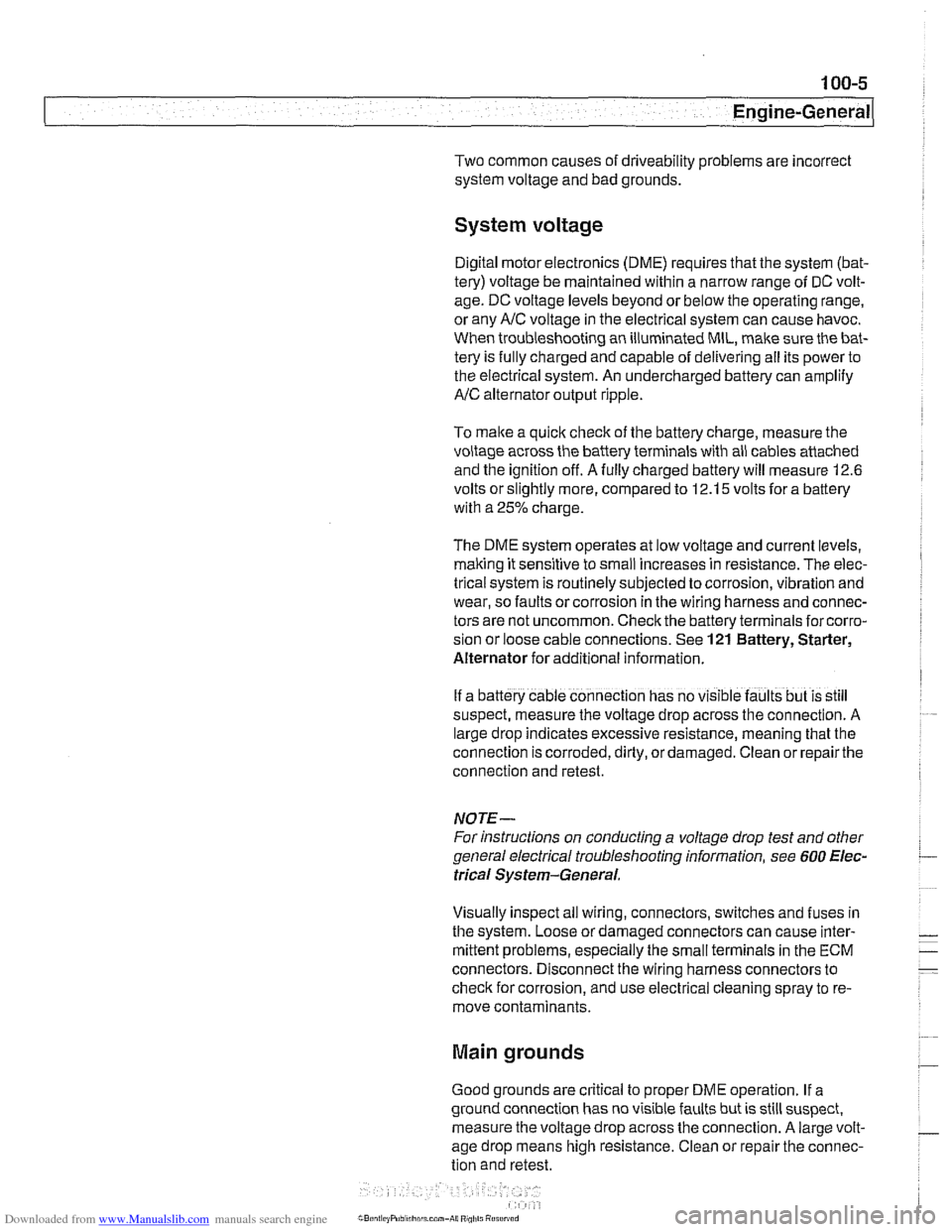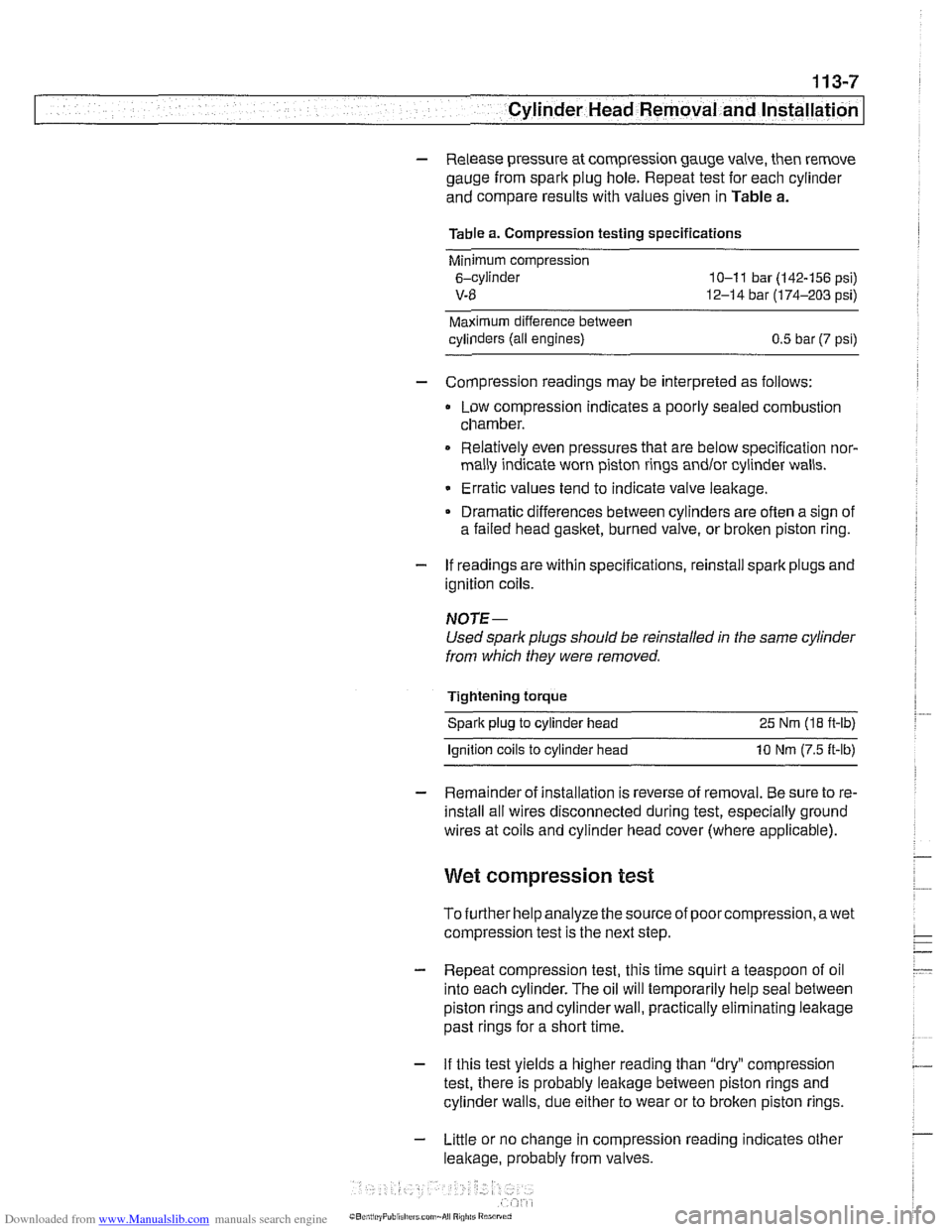Page 71 of 1002

Downloaded from www.Manualslib.com manuals search engine
Two common causes of driveability problems are incorrect
system voltage and bad grounds.
System voltage
Digital motor electronics (DME) requires that the system (bat-
tery) voltage be maintained within a narrow range of DC volt-
age.
DC voltage levels beyond or below the operating range,
or any
AIC voltage in the electrical system can cause havoc.
When troubleshooting an illuminated MIL, make sure the bat-
tery is fully charged and capable of delivering all its power to
the electrical system. An undercharged battery can amplify
AIC alternator output ripple.
To
make a quick check of the battery charge, measure the
voltage across the battery terminals with all cables attached
and the ignition off.
Afully charged battery will measure 12.6
volts or slightly more, compared to 12.1 5 volts for a battery
with a 25% charge.
The DME system operates at low voltage and current levels,
making it sensitive to small increases in resistance. The elec-
trical system is routinely subjected to corrosion, vibration and
wear, so faults or corrosion in the wiring harness and connec-
tors are not uncommon. Check the battery terminals
forcorro-
sion or loose cable connections. See 121 Battery, Starter,
Alternator for additional information.
If a battery cable connection has no
v~sible faults but is still
suspect, measure the voltage drop across the connection. A
large drop indicates excessive resistance, meaning that the
connection is corroded, dirty, or damaged. Clean or repairthe
connection and retest.
NOTE-
For instructions on conducting a voltage drop test and other
general electrical troubleshooting information, see
600 Elec-
trical System-General.
Visually inspect all wiring, connectors, switches and fuses in
the system. Loose or damaged connectors can cause inter-
mittent problems, especially the small terminals in the ECM
connectors. Disconnect the wiring harness connectors to
check for corrosion, and use electrical cleaning spray to re-
move contaminants.
Main grounds
Good grounds are critical to proper DME operation. If a
ground connection has no visible faults but is still suspect.
measure the voltage drop across the connection. A large volt-
age drop means high resistance. Clean or repair the connec-
tion and retest.
LBuntr.yP~sbhnllcn.can#-AII A,~iltl Rcsrwsd
Page 101 of 1002

Downloaded from www.Manualslib.com manuals search engine
. .- . --
Lr -- - - - -- Cylinder Head Removal and Installation I -
- Release pressure at compression gauge valve, then remove
gauge from spark plug hole. Repeat test for each cylinder
and compare results with values given in Table a.
Table a. Compression testing specifications
Minimum compression
6-cylinder
10-1 1 bar (142-156 psi)
V-8 12-14 bar (174-203 psi)
Maximum difference between
cylinders (all engines)
0.5 bar (7 psi)
- Compression readings may be interpreted as follows:
Low compression indicates a poorly sealed combustion
chamber.
0 Relatively even pressures that are below specification nor-
mally indicate worn piston rings
andlor cylinder walls.
Erratic values tend to indicate valve leakage.
Dramatic differences between cylinders are often a sign of
a failed head
gasket, burned valve, or broken piston ring.
- If readings are within specifications, reinstall spark plugs and
ignition coils.
NOTE-
Used spark plugs should be reinstalled in the same cylinder
from which they were removed.
Tightening torque Spark plug to cylinder head 25 Nm
(18 ft-lb)
lanition coils to cylinder head 10 Nm (7.5 ft-lb)
- Remainder of installation is reverse of removal. Be sure to re-
install all wires disconnected during test, especially ground
wires at coils and cylinder head cover (where applicable).
Wet compression test
To further help analyze the source of poorcompression,awet
compression test is the next step.
- Repeat compression test, this time squirt a teaspoon of oil
into each cylinder. The oil will temporarily help seal between
piston rings and cylinder wall, practically eliminating leakage
past rings for a short time.
- If this test yields a higher reading than "dry" compression
test, there is probably leakage between piston rings and
cylinder walls, due either to wear or to broken piston rings.
- Little or no change in compression reading indicates other
leakage, probably from valves.
Page 142 of 1002
Downloaded from www.Manualslib.com manuals search engine
I Cvlinder Head Removal and Installation
4 Install secondary chain tensioner on cylinder head (arrows).
Keep tensioner compressed using BMW special tool 11 3
291 or suitable pin.
< Install exhaust camshaft splined sleeve. Confirm that gap in
sleeve splines aligns with corresponding gap in
camshaft
splines (arrows).
Slide splined shaft onto exhaust camshaft. Be sure that locat-
ing tooth of shaft fits into spline gaps of camshaft and splined
sleeve
(arrows).
- Push splined shaft in further to rotate splined sleeve until the
three threaded holes in primary chain sprocket are centered
in the small slots of the splined sleeve.
4 Place intake and exhaust sprockets in BMW special tool 11 6
180. Position spline gap on intake sprocket (arrow) as shown
and place secondary chain on sprockets.
Page 143 of 1002
Downloaded from www.Manualslib.com manuals search engine
-7 Cylinder Head Removal and lnstallat~on -- -- - -
Remove chain and sprockets from tool and slide sprockets
on camshafts. Confirm that gap in intake sprocket splines
lines up with corresponding gap in camshaft splines (arrow).
CAUTIOI\C
Do not alter position of sprockets with respect to chain when
removing
from special tool 11 6 180.
< Align locating tooth of splined shaft with gaps on camshaft
and sprocket. Slide splined shaft onto intake camshaft until
approx.
1 mm (0.04 in) of splines (arrows) are visible.
4 Install intake camshafl spring plate so that FRONT mark is
visible. Install mounting nuts (arrows) finger tight.
Insert sprocket mounting bolts (arrows) on exhaust side
camshaft assembly.
Initially tighten to approx.
5 Nm (44 in-lb) and then back off
by half a turn.
Page 182 of 1002

Downloaded from www.Manualslib.com manuals search engine
11 6-6
Cylinder Head and Valvetrain
4 Before machining the head to correct for warpage, measure
the total height
(A) (thickness of the cylinder head). Minimum
height specifications are given in Table a. Cylinder head
height.
NOTE-
6 cylinder and V-8 engines share cylinder head height spec-
ifications.
Table a. Cylinder head height
New Minimum height
(A)
140.0 rnrn (5.512 in.) 139.7 rnrn (5.500 in.)
Valves, leak test
To test the valves for leakage, the cylinder head must be dis-
assembled with camshafts and camshaft carriers removed.
With valve assemblies and spark plugs installed, place the
cylinder head on a workbench with the combustion chamber
facing upward. Fill each combustion chamber with a thin non-
flammable liquid. After fifteen minutes, check the level of the
fluid. If the fluid level in any cylinder drops, that cylinder is not
sealing properly.
Camshaft wear
Camshaft wear is usually caused by insufficient lubrication.
Visually inspect camshaft lobes and journals for wear. Cam-
. ~~ shaft wear specifications are given in Table b. Camshaft
wear specifications.
CA UTIOI\C
If the camshaft is being replaced due to cam lobe wear, it is
recommended that the corresponding lifters should also be
replaced to avoid damaging the new camshaft
Table b. Camshaft wear specifications
6 cylinder engines V-8 engines
Axlal play 0.150-0.330 rnrn 0 200-0 360 rnrn - .-
(0.0060-0 013 in.) (0.008 - 0.014 in ) - - Radlal play 0.020-0.054 rnrn 0.040-0.074 rnrn
(0.0008-0.0021 in.) (0.016 - 0.029 in.)
Page 208 of 1002
Downloaded from www.Manualslib.com manuals search engine
11 6-32
Cylinder Head and Valvetrain
4 Install secondary chain tensioner (arrows). Keep tensioner
compressed using
BMW special tool 11 3 292 or suitable pin.
4 Fit exhaust camshaft splined sleeve. Confirm that gap in
sleeve splines aligns with corresponding gap in carnshaft
splines
(arrows).
Slide splined shaft onto exhaust camshaft so that locating
tooth of shaft fits into spline gaps of camshaft and splined
sleeve
(arrows).
- Push splined shafl in further to rotate splined sleeve until the
three threaded holes in primary chain sprocket are centered
in the small slots of the splined sleeve.
Page 209 of 1002
Downloaded from www.Manualslib.com manuals search engine
Cylinder Head and valvetrain1
< Place intake and exhaust sprockets in BMW special tool
11 6 180. Position spline gap on intake sprocket (arrow) as
shown and place secondary chain on
sprocitets.
< Remove chain and sprockets from tool and slide sprockets
on camshafts. Confirm that gap in intalte sprocket splines
lines up with corresponding gap in camshaft splines (arrow).
CAUTIOI\C
Do not alter position of sprockets with respect to chain when
removinq from saecial tool 11 6 180.
4 While aligning locating tooth of shaft with spline gaps on
camshaft and sprocket, slide spiined
shaft onto intalte carn-
shaft until approx. 1 mm (0.04 in.) of splines (arrows) are
visible.
4 lnstall intake camshaft spring plate so that FRONT mark is
visible. install mounting nuts (arrows) finger tight.
Page 296 of 1002
Downloaded from www.Manualslib.com manuals search engine
11 7-60
Camshaft Timing Chain
< Install and tighten down threaded locating studs (arrows) in
end of exhaust camshaft.
Tightening torque Exhaust camshaft locating
stud 20 Nrn (15 ft-lb)
4 Install secondary chain tensioner on cylinder head.
- Make sure tensioner is locked in compressed position as
described earlier.
Fit exhaust camshaft splined sleeve, aligning gap in sleeve
splines with corresponding gap on
camshaft splines
(arrows).